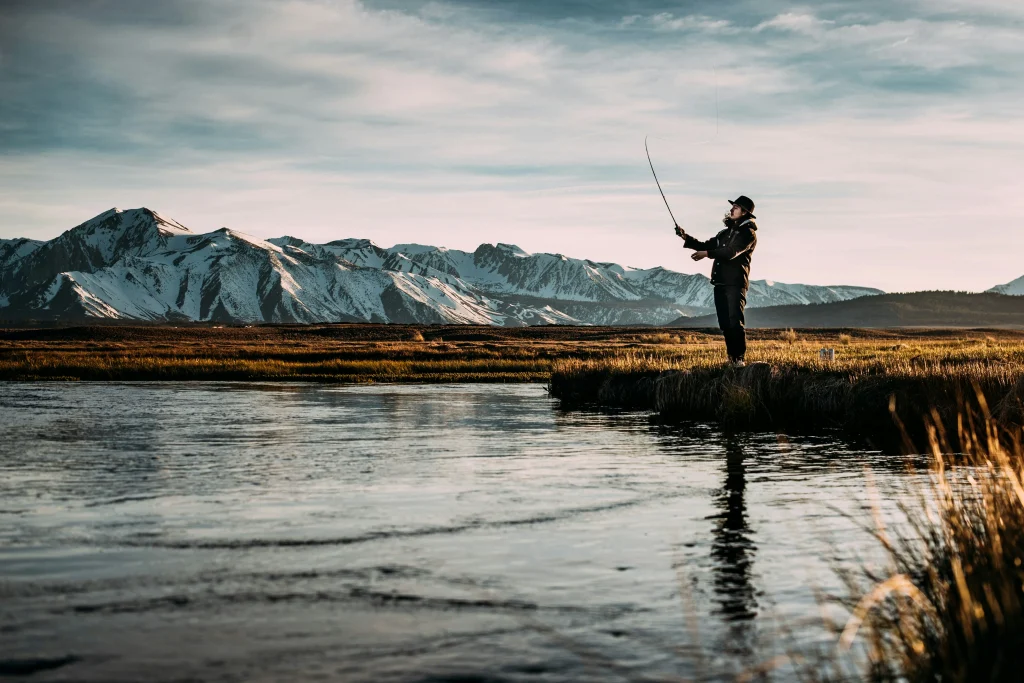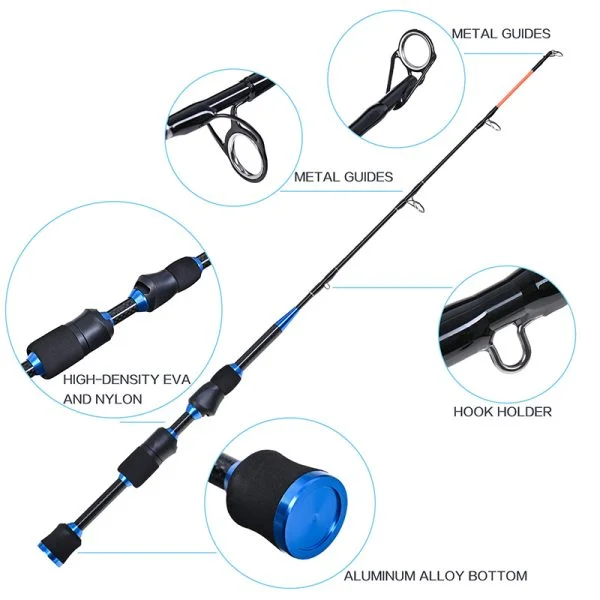The key differences between heavy and light fishing rods in advanced angling are focusing on technical parameters like action, power ratings, and material composition. Light rods, often made with high-sensitivity carbon fiber, excel in finesse fishing and precision casting for smaller fish, while heavy rods, reinforced with composites, provide strength and leverage for large gamefish and tough conditions. The applications also cover how to match rods with reels, lines, and lures based on weight class, environmental factors, and target species, offering expert recommendations for optimal performance in various fishing scenarios.

What Defines Heavy and Light Rods in Technical Terms?
Technical Parameters that Distinguish Heavy from Light Rods
In advanced angling, the distinction between heavy and light rods begins with action and power ratings. Fast-action rods bend at the uppermost part, right below the tip. They’re sensitive to the lightest of nibbles, sending vibrations straight to your hand. This responsiveness is typically associated with lighter rods but can also be engineered into heavy rods for specific applications.
Rod power—its resistance to bending—is equally critical. Heavier rods are good for larger fish, while lighter ones work better for smaller ones. Power classifications range from Ultra Light to Ultra Heavy, and these ratings directly influence line compatibility and target species suitability.
Material and Structural Differences
The composition of a rod defines its core characteristics. Carbon rods are light and feel good when fishing; they have high strength and excellent tensile strength, and can handle fish of different sizes. Lighter models often use 30T carbon cloth for enhanced sensitivity, while heavier models integrate multi-layer composites to increase rigidity without sacrificing flexibility.
Heavy-duty models typically feature reinforced spines and thicker walls to support high-load conditions. Conversely, ultralight rods focus on tapering and slender profiles to maintain touch sensitivity during finesse presentations.
Load Ratings and Power Classifications
Rod markings provide a road map for selection. A common rod marking will look like this: Spin MH 732 Line Wt 10-15 lb, Lure Wt ¼ – ¾ oz. These specs indicate not only the rod’s length but also its optimal line weight range and lure compatibility—critical metrics when choosing between heavy or light configurations.
How Do Rods Perform in Specialized Environments?
Light Rods: Sensitivity and Feedback
Light rods excel in environments where subtlety matters. The slender and highly sensitive rod tip effectively enhances the operational sensitivity, which is essential when targeting small or cautious species. Their ability to transmit even minute vibrations makes them ideal for precision casting in calm waters or tight terrain like mountain streams.
Heavy Rods: Strength-Based Scenarios
Heavy rods are built for leverage. Thanks to their fast-moving tips and strong backbones, fast-action rods are great for pulling fish out of heavy cover. The reinforced structure allows you to exert significant pressure during hook sets or when retrieving through vegetation or rocky bottoms.
Performance Metrics by Various Scenarios
In finesse fishing or ultralight tactics, prioritize responsiveness, tip control, and casting accuracy. In contrast, offshore or predator-focused scenarios demand load endurance, torque transfer efficiency, and backbone rigidity—all hallmarks of heavy-action builds.
When Should You Use Light vs Heavy Rods Based on Technique?
Ultralight Tactics Ideal for Precision Casting
Ultralight setups allow you to cast micro lures with pinpoint control. The soft rod tip improves the long-distance casting performance of small baits, which is crucial when working narrow channels or pressured waters where stealth is key.
Light Rods Excel in Finesse Fishing Scenarios
Finesse techniques rely on delicate lure presentation. It can play to its unique advantages in small streams when fishing for target fish such as horse mouth, blue tip, red eye, and trout. The medium-fast adjustment design captures every message from subtle bites without overloading the rod’s flex point.
Which Laike’s Model Excels at Ultralight Control?
If you’re seeking unmatched precision in ultralight fishing, explore this fishing rod designed specifically with a carbon body that delivers both tactile feedback and fatigue-free handling.

When Do You Need Heavy Rods Instead?
When dealing with large game fish or deep water conditions requiring vertical jigging or trolling, a heavy rod becomes indispensable. A fast-action rod can land you anything from a Largemouth to a Muskie, and from large Tuna to Billfish of all sorts—scenarios where brute strength trumps finesse.
Heavy Rods Are Better for Power Casting Techniques
Casting bulky lures over long distances requires momentum transfer through a firm blank. The stiffer backbone of a heavy rod ensures that force is not lost during acceleration phases of casting arcs or during high-resistance retrieves.
Which Model Offers Maximum Load Capacity Without Fatigue?
Look into Laike’s Carbon Fly fishing rod if you’re targeting massive freshwater predators or saltwater giants. These rods combine composite resilience with ergonomic balance.
Rod Weight Affects Handling Comfort Over Time
How Does Weight Influence Angler Endurance?
Holding a rod all day demands more than just technique—it demands comfort engineering. Its low density gives the rod an ultra-light weight, so you will not feel tired even if you hold the rod for a long time. This is especially relevant during shore-based casting sessions or prolonged trolling runs offshore.
Can You Balance Performance with Ergonomic Design?
Modern designs incorporate cork handles, EVA grips, and lightweight reel seats that reduce pressure points across your palm while maintaining structural integrity. The handle is made of cork, with good texture and feel. These features allow you to fish longer without compromising control.
Innovations Improve Handling Across Weight Classes
Advanced models integrate carbon cloth layering techniques that optimize both stiffness-to-weight ratio and fatigue resistance. Even if you fish all day with high intensity, the angler’s arms will not feel overly tired.
What Materials Differentiate Lightweight from Heavy Models?
Carbon Fiber Blends Used in Light Series Models
Carbon fiber offers unmatched strength-to-weight ratios. With both high elasticity and high strength, it combines the two characteristics of “slenderness” and “toughness”. This allows fine-tuned responsiveness while ensuring structural reliability under stress loads from active fish strikes.
Reinforced Composites Benefit Heavier Rods
Heavy-duty blanks often employ multi-axial weaves or layered glass-carbon hybrids that resist torsional flexing under extreme loads. The hardened design makes the casting of the fishing rod smoother, and the accuracy of the landing point is greatly improved.
How Should You Pair Reels, Lines & Lures Based on Rod Weight?
Complement between the Reel Features and Each Weight Class
Lightweight spinning reels enhance balance on finesse setups. Whether it is normal fishing or daily practice, the lightweight body can greatly reduce fatigue caused by long-term casting. For heavier rods targeting big gamefish, opt for reels with reinforced drag systems capable of sustaining high tension without slippage.
Line Test Ratings Matching Specific Rod Powers
You’ll want to use heavier lines with heavy rods and light lines with light rods. Overloading either component risks breakage—either line snapback under tension or blank failure due to overload stress.
Lure Weights with Each Class Type
Rod markings guide lure weight compatibility. Lure Wt ¼ – ¾ oz indicates mid-range capability; ultralight setups may go as low as 1/32 oz, while heavy-action builds support multi-ounce swim baits or jigs depending on your target species’ strike behavior.
What Environmental Factors Impact Your Choice Between Rod Types?
Wind and Current Conditions Affect Selection
Stronger winds require heavier setups that offer better control over line slack during airborne casts. Even in strong winds, it can be accurately cast and controlled at will. Conversely, calm conditions favor lighter rigs, which allow delicate bait placement without splash disturbance.
Terrain Matters: Shoreline vs Offshore Use Cases
Shoreline anglers need versatile lengths that accommodate various casting angles around obstacles. Offshore anglers benefit from longer blanks capable of vertical jigging over drop-offs—areas where only robust setups survive prolonged battles against pelagic species.
Recommendations Help Adapt Gear Based on Conditions
You’ll find specialized options among these fishing rods tailored for both terrain types—from compact stream tools to ocean-ready power builds.
How Can You Choose Between Heavy & Light Models Like an Expert Would?
Start by identifying your primary environment (freshwater/saltwater), then match your technique (finesse/power) against your quarry’s average size profile. From there, align load capacity (line/lure rating) with desired sensitivity level—this triangulation ensures optimal equipment synergy per outing objective.
FAQ
Q1: Can I use a light rod for saltwater fishing?
A: Yes—but only when targeting smaller coastal species like mackerel or flounder in calm conditions. For larger saltwater gamefish like tuna or grouper, a heavy-action setup is essential due to the higher drag forces involved.
Q2: How do I know if my reel matches my rod weight?
A: Check both components’ specifications—reel size should correspond with the line test ranges listed on your rod blank markings. A mismatch could lead to inefficient casting or gear failure under load.
Q3: Is carbon fiber always better than fiberglass?
A: Not necessarily—it depends on application needs. Carbon fiber offers superior sensitivity and lower weight, but fiberglass provides more flexibility under extreme pressure, ideal for trolling heavy lures offshore.




